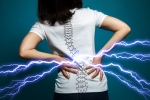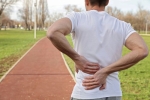Home »
Blog » Back Pain
| Stem Cell, PRP, Acupuncture in Queens & Long Island, New York
Back Pain | Stem Cell, PRP, Acupuncture in Queens & Long Island, New York
Tags: Back Pain | Posted on: 26-Jun-2020 | No of views: 13212 The course of upper back pain and how to treat it depends on the underlying cause of the condition. Even in cases where it seems obvious what started the upper back pain, such as an injury from a fall, the specific source of pain within the body can sometimes remain elusive. Regardless of whether the exact source of upper back pain can be determined, it helps to know the various potential causes in order to better narrow down which treatments may be best.
Read more
Tags: Back Pain | Posted on: 24-Jun-2020 | No of views: 3870 Diagnosis of Chronic Pain Syndrome - The first thing your doctor will do is take a thorough medical history. You’ll be asked things like: when your pain started, what it feels like (for example, burning and sharp or dull and aching), where it’s located, if anything makes it better or worse. Because certain conditions can lead to chronic pain syndrome, your doctor may order imaging tests to determine if there is joint or tissue damage that may explain your pain. For example, your doctor may order an MRI to determine if your pain is stemming from a herniated disk, an X-ray to see if you have osteoarthritis or a blood test to check for rheumatoid arthritis.
Read more
Tags: Back Pain | Posted on: 22-Jun-2020 | No of views: 3710 Anyone Can Do It - You don’t have to be flexible, fit, or comfortable wearing spandex to practice yoga. You don’t have to be young, wealthy, or able-bodied. You don’t even need a ton of free time. You can practice yoga in a wheelchair, at home in your pajamas, or in as little as 5-minute slices of time. You can do very challenging yoga poses or more gentle ones. Look for yoga classes that fit your needs or find a video online that suits you.
Read more
Tags: Back Pain | Posted on: 19-Jun-2020 | No of views: 5923 Regardless of whether spinal pain originates in the neck, upper back, or lower back, it can become bad enough to reduce your ability to enjoy an active lifestyle. But there are also some aspects that make upper back pain different from neck and lower back pain. Let’s explore 3 of them. 1 - Upper Back Pain Is Less Common - Estimates regarding the prevalence of upper back pain vary widely. However, compared to neck pain and lower back pain, upper back pain is considered relatively rare. One commonly cited reason for less upper back pain is that the thoracic spine has extra support from its attachment to the rib cage, which is critical for protecting vital organs. Meanwhile, the neck and lower back are more mobile and likelier to...
Read more
Tags: Back Pain | Posted on: 17-Jun-2020 | No of views: 5137 Most pain subsides after an injury heals or an illness runs its course. But with chronic pain syndrome, pain can last for months and even years after the body heals. It can even occur when there’s no known trigger for the pain. According to the National Center for Complementary and Integrative Health, chronic pain is defined as lasting anywhere from 3 to 6 months, and it affects some 25 million Americans.
Read more
Tags: Back Pain | Posted on: 15-Jun-2020 | No of views: 3789 Have a pain problem and wondering if yoga can help? I understand – not just as a doctor, but also as a patient. I took up yoga when I was struggling with a knee problem, well over a decade ago now. While I initially experimented with yoga with the hope that it would improve how my knee felt, I soon discovered that it could help me in much bigger ways, including bettering my mood, teaching me to better manage stress, and just plain helping me smile after a rough day. Frankly, I have found yoga to be so impactful that I can’t imagine going without it – and yes, it did seem to reduce the pain in my knee.
Read more
Tags: Back Pain | Posted on: 13-Jun-2020 | No of views: 3615 If you suffer from a lower back condition like a lumbar herniated disc or spinal stenosis your doctor will likely recommend exercise as part of your treatment program. But what should you do if your exercise regimen exacerbates your lower back condition? Should you work through the pain?
Soreness vs. pain related to a lower back condition - Before we talk about whether you should work through your lower back pain, let’s quickly look at the difference between soreness and pain related to a lower back condition. Minor soreness is a natural result of exercise, and it is especially prominent amongst those who are new to exercising.
Read more
Tags: Back Pain | Posted on: 10-Jun-2020 | No of views: 4120 Everyone experiences occasional aches and pains. Sudden pain is an important reaction of the nervous system that helps alert you to possible injury. When an injury occurs, pain signals travel from the injured area up to your spinal cord and your brain. The pain will usually become less severe as the injury heals. However, chronic pain is different from typical pain. With chronic pain, your body continues to send pain signals to your brain, even after an injury heals. This can last several weeks to years. Chronic pain can limit your mobility and reduce your flexibility, strength, and endurance. This may make it challenging to get through daily tasks and activities.
Read more
Tags: Back Pain | Posted on: 29-May-2020 | No of views: 3525 You've seen all the doctors and specialists, and you've had all the tests—then, at the end of it all, you’ve discovered that your back pain is "chronic." For many, this is an unfortunate reality thanks to conditions that are not easily treated and rarely cured such as degenerative disc disease, spinal stenosis, and spondylolisthesis. Chronic pain from these conditions often follows a pattern of low-level discomfort with intermittent flare-ups of more intense pain.
Read more
Tags: Back Pain | Posted on: 25-May-2020 | No of views: 3707 As the COVID-19 pandemic continues, patients with chronic diseases can find that stay-at-home orders pose added challenges. In many areas, medical care has been pared down to mostly urgent doctor visits, procedures, surgeries, and diagnostic tests. Many pain patients may find access to medical care or treatment more limited than ever. And stay-at-home orders can also mean spending more time around spouses, family members, or roommates, which can add even more stress to what is already a very high-anxiety situation.
Read more
Love this Post? Spread the World






















